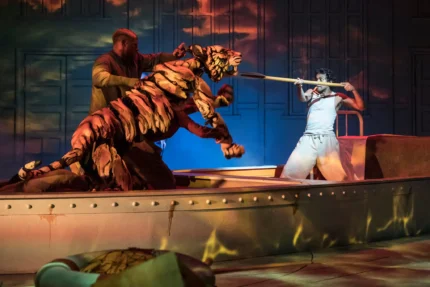 We made one of our twice-a-year visits to New York theater last month to catch almost certain Tony nominees and a couple of shows that opened just after we were there last fall. Intermittently before the certain-to-be-strange June 11 Tony Awards, we will share reviews of seven productions and performances that may or may not win, may or may not tour. The shows are: Life of Pi, Parade, Sweeney Todd, Some Like It Hot, Kimberly Akimbo, Peter Pan Goes Wrong and The Sign in Sidney Brustein’s Window. Links to other reviews in this series can be found at the bottom as the reviews run. Last November, we reviewed contenders Leopoldstadt, & Juliet and Death of a Salesman.
We made one of our twice-a-year visits to New York theater last month to catch almost certain Tony nominees and a couple of shows that opened just after we were there last fall. Intermittently before the certain-to-be-strange June 11 Tony Awards, we will share reviews of seven productions and performances that may or may not win, may or may not tour. The shows are: Life of Pi, Parade, Sweeney Todd, Some Like It Hot, Kimberly Akimbo, Peter Pan Goes Wrong and The Sign in Sidney Brustein’s Window. Links to other reviews in this series can be found at the bottom as the reviews run. Last November, we reviewed contenders Leopoldstadt, & Juliet and Death of a Salesman.
By Bill Hirschman
On rare occasions, you run into some people who have dismissed seeing plays or musicals without having seeing one, people therefore who don’t understand the absolutely unique magic of live Theater.
We’d suggest taking them, dragging them if need be, to see the current production of Life of Pi. Doubtless, they will leave the Gerald Schoenfeld Theatre saying, “Why didn’t you tell me this is what theater can be?”
The deft merging of playwriting, acting, direction, sensory designs – all of it unassailable — is catapulted to a completely different level with some of the most breath-stopping puppetry in design and performance seen on a Broadway stage.
Indeed, while there is a chance it will tour, the scope and depth of the production values may require you to see this in New York City to benefit from the complete immersive experience.
The plot is derived from Yann Martel’s 2001 novel and Ang Lee’s 2012 film, and adapted here by playwright Lolita Chakrabarti: An Indian teenager escaping a sinking ship ends up adrift on a lifeboat with a variety of creatures, notably a terrifying massive Royal Bengal tiger.
But the achievement is shared among video and animation design by Andrzej Goulding, the evocative score by Andrew T. Mackay, fully immersive sound by Carolyn Downing, lighting by Tim Lutkin, scenic and costume design by Tim Hatley and the overarching vision of director Max Webster—almost all names you haven’t heard of and are usually at the bottom of a review, but deserve the utmost acknowledgement for their crucial creation of a vivid world more intense than the real world.
Of course, the real triumph is the puppet design by Nick Barnes and Finn Caldwell, choreographed by Caldwell, and animated to an impossible level of existence by a cadre of actors/puppeteers.
Decades ago, puppetry evolved far beyond Kukla and Ollie hand puppets – pay honor to Bil Baird’s expressionistic marionettes, the imposing title steed in Warhorse, the evolving design of Milky White in succeeding editions of Into The Woods.
But the tiger is not just brought to life but elevated to a mythical level by a rotating trio of artists out of a crew of eight. It’s crucial to understand that this full-sized tiger – like all of the menagerie —does not attempt to be a photographic recreation. Instead, it’s all muscles and limbs and skeleton covered with patches of fur in a celebration of theatricality often created from pieces of the shattered ship – and all the more terrifying.
The story set in the late 1970s centers on 16-year-old Pi whose family operates a zoo in India, but is prompted by political unrest to take a Japanese freighter to Canada with their animals on board. During a storm, the ship sinks and Pi is the only human to reach a lifeboat. But over time, he is joined by a zebra, a hyena and an orangutan. And then, climbing aboard is the tiger Richard Parker, misnamed for the hunter who captured him.
The cast representing Pi’s family, neighbors and later ship crew also lend their skills animating a large array of creatures in the family zoo who escape to the lifeboat. They populate the raging ocean with shining fish and swimming turtles, even floating driftwood from the wrecked ship. Often, these surfeit of gifts can be missed in a passing second or two: For instance, for just a few seconds, an orangutan in the zoo swings from one tree to the next holding her baby.
Adrift for 277 days before being rescued, the journey is marked by alliances and death and communion. Under it all are serious themes about religion, coexistence, reality, a dangerous world with the ever-present likelihood of death, the impossible to ignore natural reality of a dog-eat-dog survival.
Again, every facet for the eyes and ears is superlative, but notably, the play opens, closes and returns regularly to a Mexican hospital ward where Pi is recovering and being questioned by authorities. So acknowledge the stagecraft as that spare and antiseptic environment instantly and fluidly morphs into the family zoo, the unseaworthy ship and the ever rotating lifeboat in the middle of an ocean at the mercy of weather.
Life of Pi is nominated in the Tonys for direction, scenic design, costume design, lighting design and sound design.
Review of Sweeney Todd, click here.
Review of Some Like It Hot, click here
Review of Peter Pan Goes Wrong, click here.
Review of Parade, click here









 A PaperStreet Web Design
A PaperStreet Web Design
